The Gadhimai festival, the world’s largest organized animal sacrifice, is again underway in Nepal. Over the course of two days, starting December 3rd, thousands of buffalo and hundreds of thousands of smaller animals – including goats, sheep, pigs, chickens, pigeons, and rats – will be slaughtered. They are sacrificed as offerings to Gadhimai, a goddess locally credited with rescuing the festival’s founder, Bhagwan Chaudhary, from imprisonment during the 18th century.
Readers previously familiar with Gadhimai may be confused that it’s taking place at all. The festival is traditionally held every five years, and following the last event in 2014, it was widely reported by news media and animal protection organizations that Gadhimai 2019 had been “cancelled.” The next festival, if held at all, would be completely bloodless. Such declarations were premature, based on remarks by a single temple committee member, which he later recanted. In August 2016, the Supreme Court of Nepal did rule to ban animal sacrifice nationwide, but ordered that it be phased out gradually rather than abolished all at once. The timeline for such a phase out has still not been set, and so without any legal enforcement of the ban, activist efforts to persuade the temple committee to give up sacrifice voluntarily have been unsuccessful.
Fortunately, a ban on transport of sacrificial animals into Nepal from India, where many worshipers come from, has been ordered by the Indian Supreme Court at the behest of the organization People for Animals, and enforced with the help of Humane Society International. Combined with outreach efforts led by Jane Goodall Institute (JGI) Nepal, and anti-sacrifice protests held by groups like Federation of Animal Welfare Nepal, we may hope that the final death toll from Gadhimai 2019 will at least be much less than previous festivals.
I myself have never witnessed the bloodshed of the Gadhimai festival in person. Nonetheless, in October 2016 I obtained a rare firsthand insight into the motivations behind the practice, when I visited the town of Birgunj where it is held, and met the high priest of Gadhimai temple, Manghal Chaudhary. Chaudhary agreed to a video interview with me and Birendra, a representative from JGI Nepal. Our conversation was at turns illuminating, disturbing, and startling. I came away unsettled but also grateful for the opportunity to glimpse the world’s largest animal sacrifice through the eyes of the man in charge of it.
As a resource for fellow activists to better understand, and so combat, future Gadhimai festivals and similar sacrificial rituals, I have decided to publicly share my conversation with Manghal Chaudhary. The videos below record the original conversation (in two parts) in Nepali. The translation that follows was commissioned by JGI Nepal on behalf of Animal People, Inc., and has been revised for clarity.
Wolf Gordon Clifton: What is the reason for the Gadhimai festival?
Manghal Chaudhary: The Gadhimai festival began in the early Sena period about 500-600 years ago. This is our tradition and culture. Our ancestors passed down the tradition of worshiping the great goddess. Here we worship the goddess of Makwanpur Gadhi [the location of the fort where Bhagwan Chaudhary, who began the Gadhimai sacrifice, is said to have escaped imprisonment with divine aid]. People worship Gadhimai expecting their wishes to get fulfilled. The Gadhimai festival is celebrated every fifth year since it can’t be practiced yearly. This festival takes place in the month of Mangsir starting from Panchami to Aasthami [days 15-18 of the eighth month of the Nepalese calendar].
Who is the goddess Gadhimai? How does she benefit from killing animals?
Gadhimai is an manifestation of the goddess Kali. There are nine goddesses, and among them Kali Mata is the most powerful one. … The demon Maisa Sur was killed by Kali, [who is depicted]carrying a sword in one hand and a skull in another, with her tongue sticking out. People saw her fierce look and her want for blood, and thought that seeing death would make her happy. So they started sacrificing animals in the belief that she would fulfill their wants and desires. … We used to sacrifice animals in Makwanpur Gadhi. But it was inconvenient, so we shifted our sacrificing tradition here [to the town of Birgunj].
Can you tell us if there are any advantages to sacrificing animals?
One of the main reasons or advantages of sacrificing an animal is self-satisfaction. People, in the belief that their wish will be fulfilled, feel satisfied by sacrificing.
Does animal sacrifice contradict Hindu teachings such as ahimsa, the avoidance of harming others?
There’s nothing like ahimsa in our Hindu tradition. You people go and check Pashupatinath [a Hindu temple in Kathmandu], where nine buffaloes are sacrificed every day. We have been to the high court and Supreme Court as well to discuss this matter, but our advocate made it clear that no one can interrupt our traditional teachings.
Is it true that the 2019 Gadhimai festival will not include animal sacrifice?
Didn’t I tell you? The Supreme Court gave its decision in our favor. We have that in written form as well. The government of Nepal, Gadhimai management committee, and our local community have all decided that as the Supreme Court told us, we must decide in advance when we will sacrifice animals, and notify the check posts [which worshipers with animals must pass through]that we are holding a managed sacrificial ceremony. Now, at every check post people must first declare, before bringing any kind of meat supplies, whether it’s for general eating or for sacrificing. No, it hasn’t been stopped.
Could the temple committee prevent general practitioners from sacrificing animals?
The temple committee surely doesn’t have any right to stop the sacrifice. You people [animal protection activists]have to spread awareness among the practitioners. We don’t inspire or tell any people to practice this tradition – they do it by their own wish. There are people who bring thousands of animals to sacrifice, but there are some people who come here with hands full of rice as well [as a non-animal offering].
Some people say that Hindu traditions teach us to behave peacefully, but some say goddesses like Kali expect us to sacrifice. What do you have to tell us about that?
Everybody has their own different cultures. We don’t call on people to give offerings – they come here by their own wish. We offer sacrifice to Nawa Durga and Kali. Not all deities are offered animal sacrifices.
What difficulties do you foresee in successfully holding a bloodless Gadhimai festival?
Look, there has been a lot of discussion regarding this matter. As I told you, people bring animals to sacrifice by their own wish. We can’t beat them up and chase them away. It’s not as though we [Gadhimai priests] can stop bringing animals ourselves and then the problem will be solved. Even people in high administrative positions bring animals. I have heard that every day 50-100 trucks of buffaloes are supplied to Kathmandu [for sacrifice]. Chickens too. Gurus in many places have been threatened with jail [no explanation given]. Even I was once requested at the Supreme Court. We don’t praise them for sacrificing; it’s their choice.
How many animals were sacrificed during the last festival?
Around ten thousand buffaloes were offered during the last mela [religious festival]. The exact record or number of buffaloes sacrificed is kept by the mela management committee. Around 10 million people came here. Looking around, animal sacrifices were done all around [the temple], down to the river. … Last year, there were fewer buffaloes [compared to previous festivals]but other animals were constant. … The number of animals other than buffalo is too many. The Supreme Court of Nepal has suggested that we work together to conduct this mela in a better organized way.
What is done with the offerings once they have been sacrificed?
After the animals are sacrificed, their intestines and skin are removed and the other body parts are taken as prasad [sanctified food]. They take the body of every animal sacrificed. The flesh is used as meat and cooked and eaten by those who brought it here. Regarding the buffalo, some people take the remaining parts away in their personal vehicles, up to Jhapa district in the eastern part of Nepal, or up to Butwal in the western part. These place are not so far, around one day’s distance only. As the mela takes place during the winter season, there is no fear of meat becoming rotten.
The tragedy is that every day animals are slaughtered in Kathmandu. We were housed at a five star hotel [during a visit to Kathmandu]. During dinner time and lunch time, chicken, eggs, beef, and mutton were served. We ourselves are vegetarian, but they offered such food to us. When such animals are used as food, no one criticizes, but they will criticize us [for sacrificing animals].
How much money does the temple make from selling animals’ meat and parts?
We don’t sell meat. [During the last festival] a committee was formed to sell meat. So a conflict arose. The head of the sacrificed animal was buried and the body parts were taken as meat, and then the committee called for tenders to sell the meat. But later they claimed it. They stopped buyers from taking the meat, saying sacrificed animals’ bodies should be used as prasad. [Everyone] can come to eat prasad.
How much profit does the temple committee make from money donated at Gadhimai Temple?
We have a group of priests from around 100 families. … If anyone offers gold or silver, and if the committee made a receipt of that, then the committee will keep it. Otherwise we priests share all the offerings.
During the Gadhimai Festival, there are many problems with mismanagement, such as overcrowding, no first aid or health camp, no toilets, no drinking water, lots of pollution, lost children, the temple pond getting dirty, and too much noise. Why doesn’t the committee use its funds to resolve this?
The committee does think of these problems. We have kept a health camp in the festival area.
Why has none of the media coverage mentioned the arrangements made by the committee?
The media writes whatever they want. If we don’t give them money, they don’t write. Currently, do you know what the national daily paper wrote? Kantipur wrote that the Supreme Court ordered to stop sacrifice. Do you believe it is true? One day all of a sudden lots of people come here, and they bathe in the same pond. People should have awareness that the pond is not a place to throw slippers. When we clean up, tons of slippers will come out of the pond. We all should raise awareness about these things – big organizations like yours and [the temple committee]should work together for awareness.
How much of the animals’ remains go to waste? Does wasting the remains cause any harm?
Marginalized people take away the edible meat. We don’t let people take away heads, as we need to count the heads for our records. Stomachs and intestines are buried in big pits. We have to put around fifty sacks of salt, green tea powder, and spray over the whole mela arena to get rid of the foul smell of carcasses and waste, and reduce risk of disease. These things are done by the temple committee.
As head priest, you personally do not sacrifice any animals, but the conduct of sacrifice happens under your supervision. In your view, how much does this conduct affect your karma and the karma of the general public?
Karma, or conduct, is of two types. On the one hand, people should work to earn good karma for themselves, and on the other hand, they should help others, say by feeding them or helping with their expenses. People bring many things to offer here, and so we need to address that. That is the compulsion of karma. We have to sacrifice animals because people bring them here.
You say that marginalized people take away the meat. What do they do with it? Do they sell it or eat it?
They will dry out the meat and consume it. 20 kilograms of meat… [provides for]personal consumption for 2-3 years. If they want to sell it, then they will work hard and take away 10 dead bodies [instead of just one].
Being a priest of Gadhimai Temple, how do you feel knowing Gadhimai has such a negative reputation? This place is famous for negativity, so what would you suggest to make it famous in a positive way?
Earlier, I have shared suggestions before the mela. Lots of intelligent people need to come here and work for years [in advance of the festival]. Last minute work just before the festival doesn’t work. You need to place big billboards around, publicize in the media, work on community development. Contracts of giving and taking don’t work here. If you say, “Stop sacrifice now and I will give you millions of rupees and provide development,” that won’t work. You have to start from early on.
In Nepal, Buddhists don’t kill by themselves, but they eat meat, don’t they? In northern Nepal they push animals off from cliffs, and when they’re dead they chop up the bodies and eat them. In the Newar community as well they worship Buddha, but they eat meat daily. Now tell, without killing where does meat come from? We’ve seen these things.
But for [Hindu worshipers at Gadhimai] what I suggest is to put up billboards, do programs interacting with the public, and spread messages not to sacrifice animals. Send materials in English and people here will translate them. Personally, I don’t kill animals and I don’t eat meat.
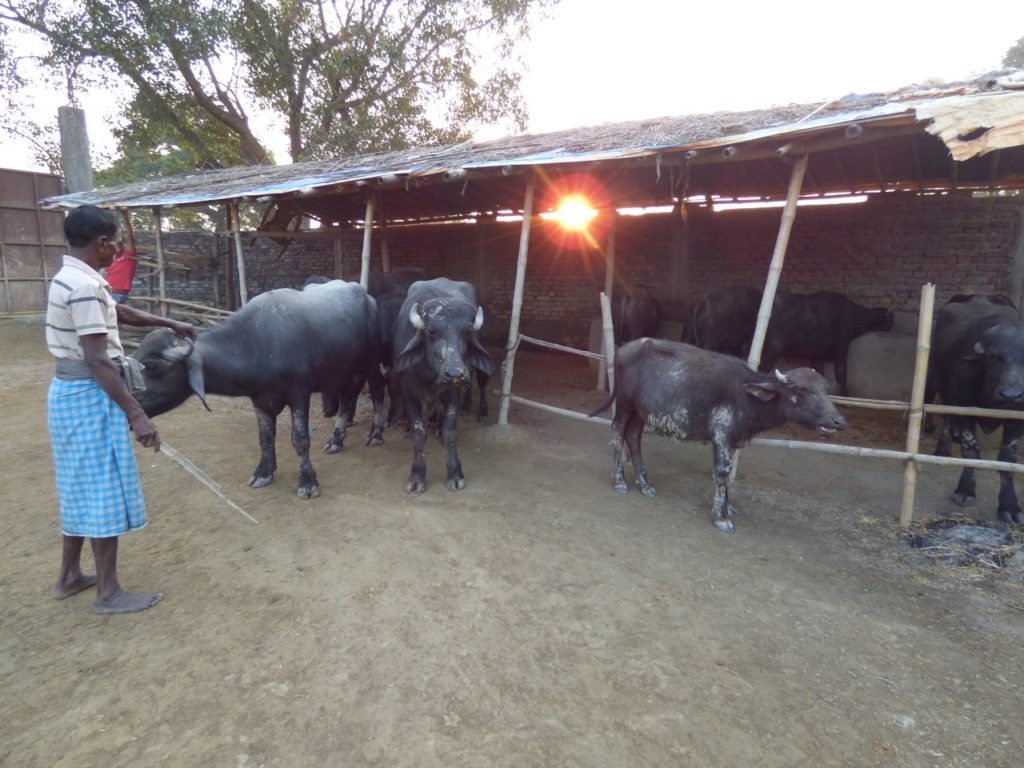
Water buffalo kept in the sacrificial arena between festivals, being herded into a shed for the night by their keeper.
Why don’t you promote the same message yourself then? Why don’t you tell people not to sacrifice, to bring this or that but not to bring animals for sacrifice?
We can’t say that. We can’t tell people to bring a specific thing – you bring whatever you wish. Whatever you offer, it’s yours to offer.
After the 2014 festival, Ram Chandra Shah from the temple trust claimed that in 2019 Gadhimai will be celebrated as a bloodless festival without sacrifice. Is this not true?
We all were there [when Ram Chandra Shah spoke]. The secretary [of the committee]was there, the vice president was there, I was there, the man’s father was there. We didn’t say we won’t do sacrifice. We said we will try to manage sacrifice as best we can, and expect the sacrifice to be less. One thing that we the committee don’t like are contracts of give and take, e.g. “You stop sacrifice and we will help you in development of this area.”
Does that mean you will be putting in your best effort to reduce the sacrifice?
We have done that. When people have awareness, [animal sacrifice]will automatically get reduced. Now in the time of science, people believe only when things are scientifically proven. But here, we move according to religious faith and innocent people’s traditional beliefs.
In the media, Ram Chandra Shah was directly quoted as claiming that in 2019 there won’t be sacrifice.
This was wrong. The media says whatever they want. If you call them and pay their expenses, they will write in your favor. We haven’t said anything to them. Do you know what the Supreme Court has written? It says all should work together. The government, mela committee, and organizations should conduct quarantine tests and manage the festival properly.
I wish people would be more aware, that instead of sacrificing animals they would offer fruits and coconuts. We have to raise awareness, then animal sacrifice will go down.
Currently none of us have said we won’t give sacrifice or that we won’t let animals be sacrificed.
You have made an enclosed arena for buffalo to be sacrificed, but why not a separate area for small animals? In the past, small animals have been sacrificed wherever people want, and there is more chance of diseases spreading. Why don’t you make a separate place for them as well?
Buffalo are giant bodied animals, and have been counted at 5,000, 7,000, up to 10,000 animals [per festival]. If buffaloes are killed just anywhere, there is more probability of accidents. You can see how big buffaloes are, and over the span of five years how big and strong they can become. Yet we have to sacrifice them, to manage them somehow. To manage the ritual and prevent accidents, to reduce chaos and prevent fear in the buffalo we made an arena to hold them. But in the case of goats, ducks, and pigeons, they are small animals. People bring these animals up to the temple, and wherever it is feasible they sacrifice them. We tried to manage them, but it was unsuccessful, because hundreds of thousands of small animals come here. It’s too difficult to manage.

The buffalo arena. As there has been controversy regarding the number of buffalo allegedly killed, I paced the arena’s perimeter myself and estimated that 3,487 buffalo could be fit into the arena at the same density as housed in the shed during my visit.
How do you regulate the weapons used to sacrifice the animals?
Weapons are checked by the sacrifice management committee [to ensure they meet standards]. They check whether the person is capable of killing or not. Butchers also bring their own personal weapons. Some [from the military]bring guns checked by their commanders.
After killing, what happens to the hides of the animals?
Hides of animals are submitted to the committee, and tendered to the shoe factory. We use the money from this sale to pay bills for water, electricity, and other festival expenses. Edible meat is taken by marginalized people, and hides are sold by the committee.
As you are the high priest, what do you personally believe in? Do you believe in pooja [prayer]with sacrifice or only a peaceful form of pooja?
I, Manghal Chaudhary, am now the 10th [generation]descendent [of Bhagwan Chaudhary]. The 11th descendent has arrived. We aren’t compelled to tell people to bring animals for sacrifice. But if people bring animals for sacrifice, then it’s our duty to offer that pooja to the Goddess. As priests, we have to do pooja two times per day. If people bring animals for sacrifice during mela, then we have to manage it. If we don’t do the sacrifice ourselves, then in order to manage it we have to deploy another to conduct the killing. We believe in the goddess Kali and must do our duty for the good of all. If we don’t sacrifice then it will harm us.
Besides the Gadhimai mela, do people sacrifice here at other times as well?
In Gadhimai it happens once a year [once every five years?]. 5-10 thousand buffalo, 100-200 thousand goats, sheep and small animals are sacrificed. But in temples like Manakamana, there are Magar priests who do sacrifice every day. At Chinnamasta Temple, Rajdevi Temple, and Bindabasinai they do sacrifice once a year. Butcher shops are always open for food consumption. But temples are the center of faith for the Hindu religion.
Friends from India come here during the mela. From south India, Bengal, Jharkhand, Udisa – we all know that sacrifices happen on a daily basis there. Even in Pashupatinath [the most influential temple in Nepal]they do sacrifice. The priest of Pashupati can explain in terms of Hindu philosophy why the buffalo is kept in a particular place, and why buffalo tails are tied up on the temple.
At last, in short, could you please say whether the act of sacrifice is right or wrong?
It depends on your belief, and what’s in your soul. I do sacrifice because I have made wishes, I have my family god here, I have done it before and will continue to do so. Every five years we have to do this ritual [the Gadhimai festival]in order to complete our pooja.
That means that even in 2019 this sacrifice ritual will be conducted?
We will continue our ritual whether people will come or not, whether they will bring animals or not. That doesn’t concern us. We will continue the rituals in our temple to fulfill our duty.
Featured image: a goat is readied for sacrifice in Nepal. Image credit Nicholas James, CC BY-SA 2.0. All other images in this post credited to the author, Wolf Gordon Clifton.

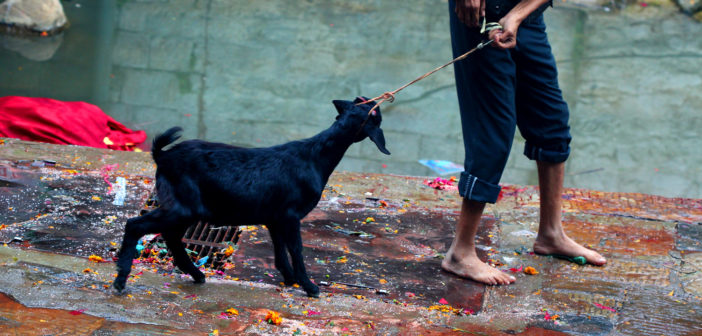
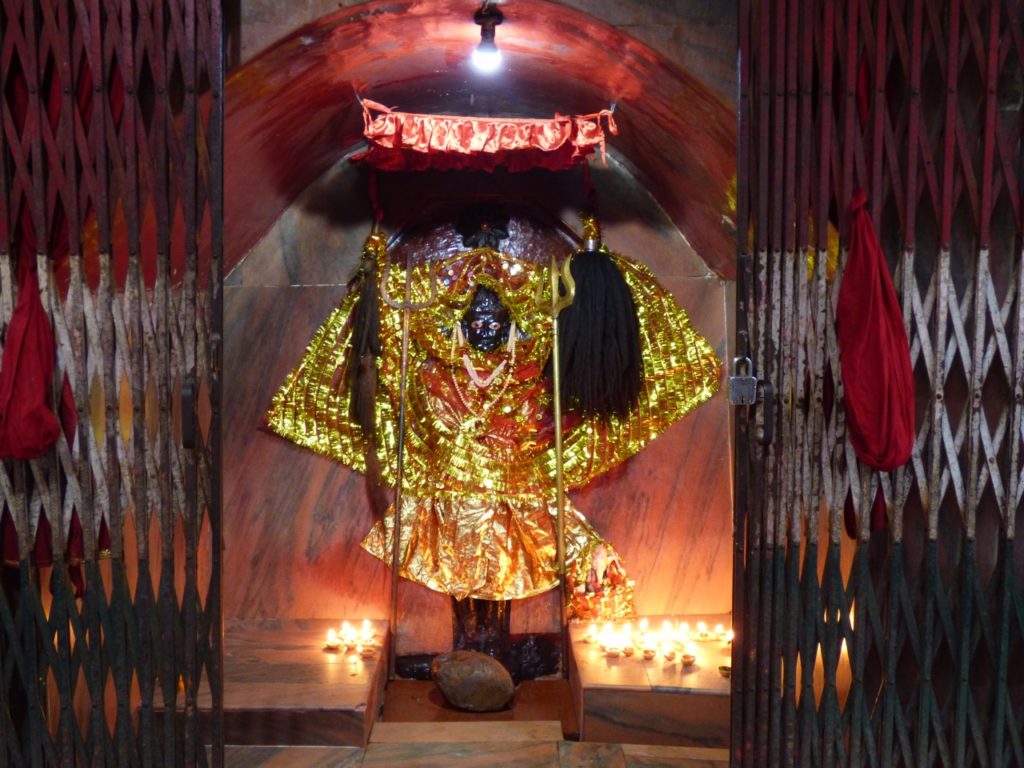
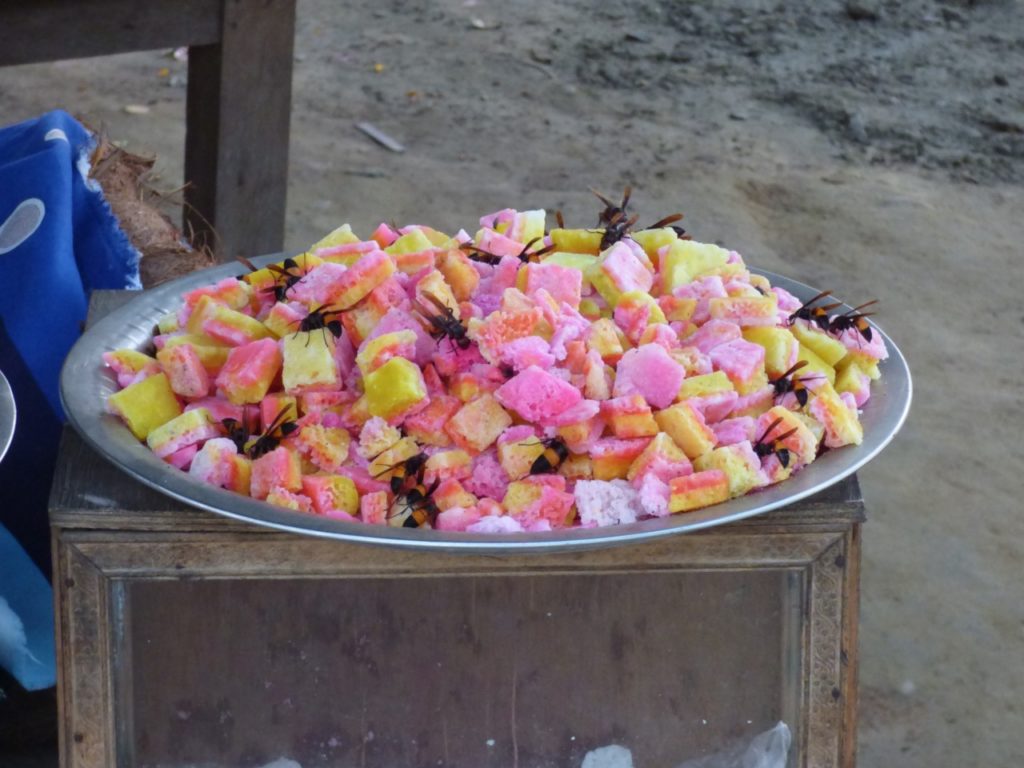
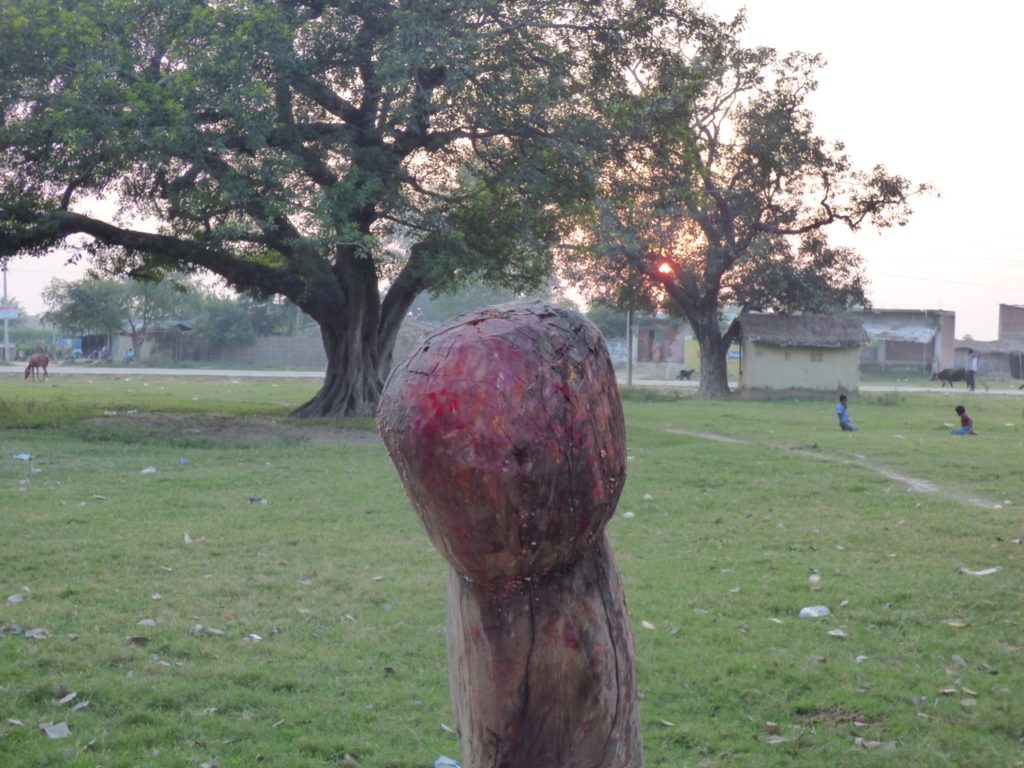
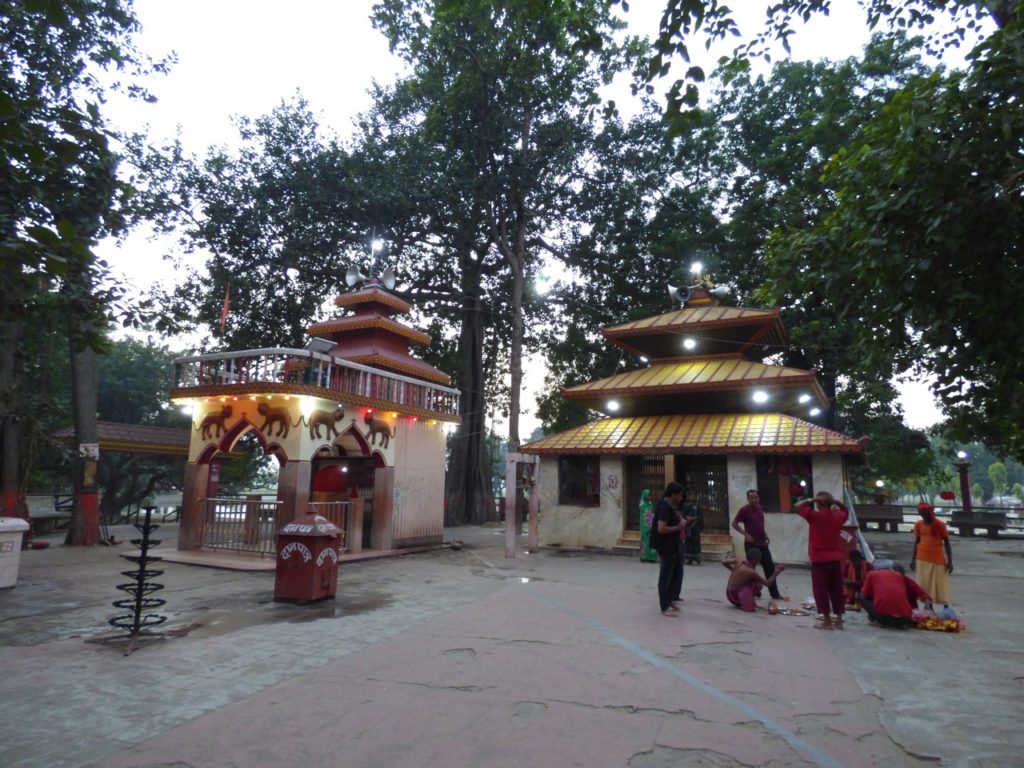

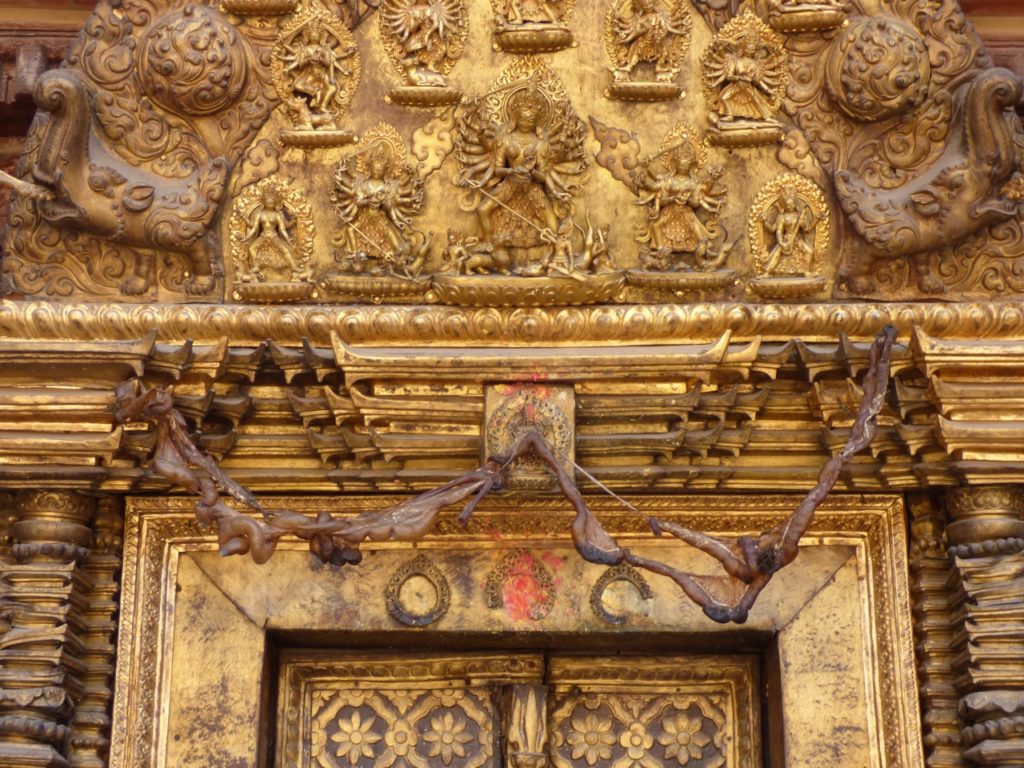




1 Comment
I am not condoning the slaughter but attempting to find a rationale for it. Clearly I don’t believe in the gods or that appeasing them makes prayers come true. I wonder if the original priests did too, or whether, originally, the practise was just an animal management practise, in a marginal ecology that just cannot support unlimited populations of animals. Actually, it does not do a good job of supporting human populations. There are huge problems with poverty, malnourishment and land management in Nepal.
Similar slaughters, albeit less focused, were commonplace in North Europe before the modern era as part of Yuletide style celebrations and the simple rationale behind them was that there just was not sufficient feed to see the animals through to Spring, when Winter thawed and vegetation grew, so it was necessary to cull a proportion off, or risk losing them all, having to choose when to support human life or not too.
Note the priest’s mention of marginal people, presumably tribal or scheduled castes.
Therefore I wonder if, in the beginning, it was just that, really just animal/resource management with a plausible story to appease sentiments, which then got out of control, and, of course, came to benefit the priests and their families hugely in terms of donations. Hence their unwillingness to question superstition.
Having said all that, of course the slaughter is eclipsed many 1.000 times over every day by industrial agriculture in the West without any need or cultural significance, but merely based on a profit interest, to the detriment of all affected.
I’d suspect the animals involved live far more pleasant, natural and productive lives than the 98%+ of animals in the American CAFODs. Which makes me wonder what place Westerners have to exercise any opinion or influence on the practise, without offering any alternative solution to the practical problems causing it; from regional poverty, to lack of education, and so on.
It’s easy to say, “just don’t do it” but what are you going to do with all the excess buffaloes, which are still key to there agricultural systems; tractors, transporters, fertilizers, nutrition suppliers. Can’t grow almonds for your latte’s milk at 5,000 ft. Can’t feed kids on it.
The story makes for great shock horror photo journalism, and may even pull in donations for certain groups, but what else does it achieve?
I tend to think the movement should turn a blind eye and lay off the developing nations, until we sort out own problems, and start helping them sort out theirs. We need to work on a ‘whole picture’ approach rather than just parachuting the troops in, telling they are bad, then leaving.
As to curing religious superstition and parasitism … if the Buddha failed at it, what hope do we?